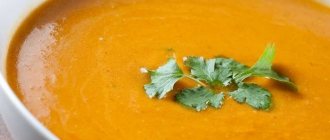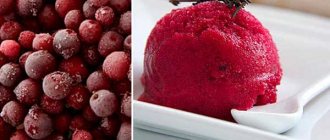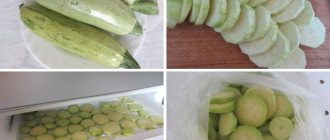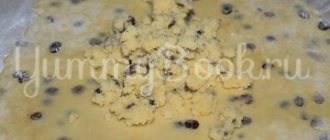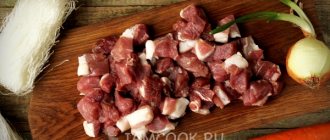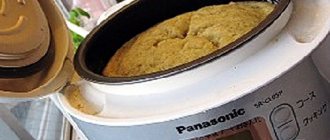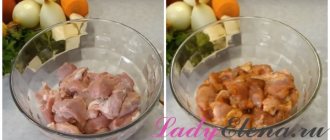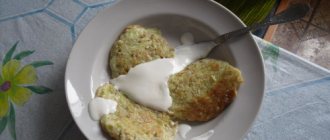January 29, 2018
Seal
- #polenta
- #garnish
- #Italian Cuisine
- #corn grits
- #Parmesan
Categories: Porridges, grains and legumes, Italian cuisine, Side dishes, Budget recipes
Polenta is an Italian relative of the Ukrainian
banosh, Moldavian-Romanian mamalyga and many other similar dishes made from corn grits in different countries. The main feature of Italian polenta is that it is prepared with milk or milk with broth and, during the cooking process, cheese is added and thanks to it, polenta has such a pleasant cheesy flavor. And, as a rule, polenta is prepared from finely ground corn grits (much finer than for traditional banosh). Polenta can be either creamy or hard, the kind that, after cooling, is cut into portions and fried in vegetable oil until crispy. I will also share the recipe for the latter, but now I suggest you familiarize yourself with creamy polenta, a delicate and very tasty side dish for goulash , stews and dishes with rich sauce.
Creamy polenta is so delicious that it can even be called a self-contained dish. Preparation of polenta is very simple, like preparing
banosh , only the consistency to which the creamy polenta is cooked is liquid, it should be like liquid mashed potatoes, remembering that it continues to thicken after removal from the heat.
When preparing polenta, you need to constantly stir it so that the grain does not burn to the bottom, so that the polenta is free of lumps and so that it does not splatter during cooking. If the polenta is left undisturbed and standing close, splashing may cause burns. Therefore, it is necessary to interfere. Luckily, with modern grains, polenta doesn't take long to cook.
As for cheese, of course you can add another type of cheese, but hard cheeses are best suited to polenta, since they do not stretch, but are evenly distributed throughout the polenta.
Ingredients
- 250 ml chicken or vegetable broth
- 250 ml milk
- 1 tbsp. corn grits finely ground polenta
- 60 grams grated Parmesan or Grana Padano cheese
- 1 tbsp. soft butter
- 2 tbsp. olive oil
- Salt to taste
1) In a small bowl, bring milk, broth and salt to a boil.
2) Add the cereal and cook, stirring constantly, until thickened.
3) Add butter, olive oil and cheese. Mix everything well.
Serve the creamy polenta hot as a side dish with a rich sauce.
Bon appetit!
See also
Italian polenta
In northern Italy, this dish is no less popular than pasta or rice. If previously it was considered the food of the poor, now it can be tasted in the most expensive and prestigious restaurants. How to prepare Italian polenta (recipe):
- Pour half a liter of milk and half a liter of water into a saucepan with a thick bottom. Place the dishes on the fire, bring to a boil and add salt.
- Pour 300 grams of coarse corn flour into the boiling liquid in a thin stream. Periodically stir the porridge vigorously with a wooden spatula until it comes away from the sides of the pan. This will take approximately one hour.
- Cut 200 grams of hard sheep cheese and 100 grams of ham into cubes. Add the ingredients to the pan ten minutes before the polenta is finished cooking. Stir and wait until the cheese melts.
- Grease a baking dish with oil, place the polenta in it and smooth it out. Sprinkle the dish with grated cheese, spread pieces of butter on it and pour milk (0.25 liters).
- Bake the polenta in the preheated oven for ten minutes.
Chef of the house: Lenten polenta and Vietnamese cutlets Alexandra Gavrilova
In the “Chef of the House” series of materials, professional chefs and simply passionate cooks share their recipes with history and stories about the recipes. The materials are released with the support of household appliances from the new Electrolux range, with which the technologies of professionals have become available in any kitchen.
Alexander Gavrilov
Founder of the Institute of Books, TV and radio presenter, first program director of the Moscow Book Festival, co-owner of the ArteFAQ club, the Sisters Grimm restaurant, Dodo and Jabberwocky bookstores, and also a big fan of cooking. While artistically preparing polenta with sweet peppers and shrimp cutlets, Alexander spoke about the similarities and differences between the culinary traditions of Europe, Russia and Asia.
Polenta with baked sweet peppers and narsharab sauce
The word “mamalyga” has evoked romantic associations in me since childhood. Moldavian literature is full of stories about how a little boy runs home, where his mother is waiting for him and cuts hot hominy flavored with salted cheese with a thread. According to the books, it seemed healthy and very tasty to me. Therefore, when I arrived in Abkhazia and found out that mamalyga is also considered a signature dish there, I really wanted to try it. Walking around Gagra, I saw a home cafe where a friendly woman was cooking hominy in a huge cauldron. She cordially offered me a bowl of porridge and even threw cheese on top, just like in my children's books. And so I ate the first spoon and realized that it was surprisingly tasteless - the hominy turned out to be fresh and lethargic. Of course, my childhood dream suffered greatly from this.
Fortunately, there are two traditions for making corn porridge. The dish, which is called mamaliga in Moldova and the Caucasus, is popular in Italy under the name polenta. The only difference between them is that hominy is made from corn flour, and polenta is made from cereal. The recipe itself has been known since the times of the ancient Romans, who, during their military campaigns, including in the Caucasus, prepared pulpmenta - porridge from crushed barley. Mamalyga is a rustic dish in which the main thing is satiety and simplicity. It is always done the same way, with minimal changes. And polenta is the food of city dwellers, adapted for a more demanding and refined taste. In Italy, there are a great variety of polenta recipes - with a variety of additions. My polenta with peppers and narsharab is just another alternative found through personal experimentation. I myself observe Lent, so my dish is completely lenten or vegetarian.
Ingredients (for 4 servings)
Corn grits Water Sweet bell pepper
1 glass 3 glasses 5 pcs.
Butter (or vegetable oil) Narsharab sauce
50 g
200 g
1. Boil three glasses of water. At the moment of boiling, pour one glass of corn grits into the water, remembering to stir the grits with a spoon.
2. Cook corn grits for 30 minutes over low heat, stirring constantly. If the cereal suddenly burns, you will have to throw out the entire pan and start again.
3. Transfer the finished porridge into a rectangular shape. Level with a spatula or wet hands. Let the polenta cool (at least 15 minutes).
4. Place whole unpeeled peppers on a wire rack in an oven preheated to 220°C. Place a tray under the grill to catch the juice from the peppers. Set the timer for 25 minutes.
5. After 25 minutes, check the readiness of the peppers. If the skin is covered with large blisters and scorch marks, and the peppers themselves are limp and wrinkled, then you can take them out of the oven.
6. Place the finished peppers into any plastic bag, tie it in a knot and leave for 15–20 minutes. After such a “steam bath”, the skins from the peppers will be easily separated by hand, without a knife.
7. Peel the skins from the peppers. Place the peeled peppers in a deep bowl and only remove the seed pod from it - sweet juice will flow out of the peppers, which will add flavor to the polenta.
8. Tear the peppers into equal strips with your hands. Clean out the remaining seeds.
9. Pour the peppers in their own juice with narsharab sauce to half the volume of the dishes. Leave for 10 minutes to marinate the peppers.
10. Cut the cooled polenta into small pieces with a spatula or knife. Melt a tablespoon of butter (or vegetable) oil in a frying pan.
11. Fry the pieces over high heat on both sides until the polenta is golden brown. 1-2 minutes will be enough.
12. Decorate the plates with narsharab, put pieces of polenta in the middle, pour a tablespoon of oil from the frying pan over them and serve with strips of pickled peppers.
Vietnamese shrimp cutlets
I have been going on vacation to Vietnam for many years and really love the local food. I like that the element of improvisation is very important in Vietnamese cuisine. Pho soup is a great dish because no two bowls of pho are the same—everyone makes it differently. This greatly develops the national culinary imagination. Unlike a Russian person, who knows that there is a certain “exemplary” borscht and it is prepared in a certain way, a Vietnamese person knows what kind of pho he personally likes and constantly experiments with flavors.
The recipe for shrimp cutlets was invented by Marianna Orlinkova, author of cookery books and my good friend. She has a book dedicated to Asian cuisines. It contains recipes that can very loosely be classified as some kind of national cuisine. In fact, they are all original, like these shrimp cutlets. There is no such specific recipe either in Vietnam or in any other country in the world, but the taste of these cutlets is surprisingly similar in feel to Vietnamese cuisine.
Ingredients (for 3 servings)
Minced pork Tiger prawns Refined vegetable oil Ginger root
300 g 9 pcs. 1 l
5 cm
Cilantro Lime Garlic Egg Fish Sauce
1 bundle 2 pcs. 4 cloves 1 pc. 150 ml
1. Place the minced pork in a deep bowl - this is where the minced meat for the cutlets will be prepared. Prepare another container for the sauce. Peel the ginger root and grate it on a fine grater. Add 2/3 of the grated ginger root to the minced meat, 1/3 to the sauce.
2. Squeeze 4 cloves of garlic into the minced meat. Stir together with ginger.
3. Chop the cilantro as finely as possible. Put 2/3 of the cilantro into the sauce, 1/3 into the minced meat.
4. Add one egg and one tablespoon of fish sauce to the minced meat. Knead the minced meat with your hands until it is homogeneous and plastic.
5. Squeeze three lime halves into the sauce. Add fish sauce in the same volume as the lime juice.
6. Pour oil into a large saucepan. Heat oil over medium heat to 160°C. If you don’t have a thermometer in your kitchen, you can estimate the temperature of the oil by eye - at 160 °C, active movement begins inside the oil, although the surface remains smooth.
7. Peel the shrimp, leaving the tails.
8. When the oil is hot, you can start making cutlets. Wet your hands with water, pinch off about a tablespoon of minced meat, spread it on your palms, place the shrimp on top and wrap it inside the cutlet. Make cutlets one at a time and immediately place them in the deep fryer using a slotted spoon. It is important that the cutlet is not very large so that the minced meat and shrimp are cooked at the same time.
9. Remove the cutlet after 2 minutes. The criterion for readiness is the pink color of the shrimp and the red blush of the cutlet. Place the finished cutlet on a paper napkin so that the oil drains and is absorbed.
10. Serve cutlets with sauce. Eat strictly with your hands, dipping the cutlets into the sauce and licking your fingers with pleasure.
Photos: Mark Boyarsky
Is polenta good for your health?
Corn is one of the most important grain crops in the world. In fact, it is the staple grain for 200 million people (,).
Cornmeal itself is not a complete source of nutrients. However, when consumed along with other nutrient-rich foods, it can have a place in a healthy diet.
Rich in complex carbohydrates
The type of corn used to make cornmeal and polenta is different from the sweet corn on the cob you enjoy in the summer. It is a starchy variety of field corn that is high in complex carbohydrates.
Complex carbohydrates are digested more slowly than simple carbohydrates. Thus, they help you feel fuller longer and provide long-lasting energy.
Amylose and amylopectin are two forms of carbohydrates in starch ().
Amylose—also known as resistant starch because it resists digestion—makes up 25% of the starch in corn flour. It is associated with healthier blood sugar and insulin levels. The rest of the starch is amylopectin, which is digested (,).
Helps maintain normal blood sugar levels
The Glycemic Index (GI) indicates how much a food can raise your blood sugar levels on a scale of 1 to 100. The Glycemic Load (GL) is a measurement that takes into account serving size to determine how a food can affect your blood sugar levels () .
Even though polenta is high in starchy carbohydrates, its GI average is 68—meaning it shouldn't raise your blood sugar too quickly. It also has a low GL, so it should not cause a spike in blood sugar after consumption ().
However, it is important to know that the GI and GL of foods are affected by what you eat at the same time. If you have diabetes, the American Diabetes Association recommends focusing on the total carbohydrate content of your food rather than the glycemic measurements of its components ()
If you have diabetes, the American Diabetes Association recommends focusing on the total carbohydrate content of your food rather than the glycemic measurements of its components ().
This means you should stick to small portions of polenta, such as 3/4 of a bowl (125 grams), and pair it with foods such as vegetables and meat or fish to balance it out.
Rich in antioxidants
The yellow cornmeal used to make polenta is an important source of antioxidants, which are compounds that help protect your body's cells from oxidative damage. In doing so, they may help reduce the risk of developing certain age-related diseases (,).
The most significant antioxidants in yellow cornmeal are carotenoids and phenolic compounds ().
Carotenoids include carotenes, lutein and zeaxanthin, among many others. These natural pigments give cornmeal its yellow color and are associated with a lower risk of developing eye diseases such as age-related macular degeneration, as well as heart disease, diabetes, cancer and dementia ().
The phenolic compounds in yellow cornmeal are flavonoids and phenolic acids. They are responsible for its sour, bitter and astringent flavors (,).
These compounds, due to their antioxidant properties, are thought to reduce the risk of developing age-related diseases. They also help block or reduce inflammation throughout the body and brain (,).
Gluten Free
Corn, and therefore cornmeal, is naturally gluten-free, so polenta can be a good grain choice if you're following a gluten-free diet.
However, it is always a good idea to carefully review the product label. Some manufacturers may add gluten-containing ingredients, or the product may be manufactured in a facility that also processes gluten-containing products, increasing the risk of cross-contamination.
Many polenta brands claim that their products are gluten-free.
Moldavian hominy: recipe
Mamalyga is the foundation of Romanian and Moldavian cuisine. According to legend, mamaliga is “a piece of the sun that God gave to the Romanians.” It is always served with sour cream, seasoned with garlic and grated cheese.
studiogi_shutterstock
You will need:
500 g corn grits
100 g butter
Salt to taste
How to cook mamalyga:
Boil water, adding oil and salt in the desired amount. When the water boils, add corn grits, remembering to constantly stir the porridge so that lumps do not form.
Now, still stirring, let the hominy cook over low heat for half an hour (no need to cover with a lid). Then turn the finished porridge onto a large plate.
If desired, add sour cream, cheese, cracklings or melted butter to the mamalyga.
Considering its rich chemical composition, high content of minerals and trace elements, vitamins, corn grits are recognized as one of the most useful and valuable food products. Dishes made from such grains, especially side dishes, are considered extremely healthy, which is why adherents of a healthy, balanced diet love to enjoy them.
What are the benefits of corn porridge? The fact is that this type of cereal can quickly and efficiently cleanse the human body of toxins, harmful substances and mucus. In addition, this dish controls and normalizes cholesterol levels in the blood. That is why nutritionists shout with one voice that corn porridge should be present in the diet at least three times a week. The proposed step-by-step recipe will help you familiarize yourself with how to properly and tasty prepare corn porridge as a side dish.
A side dish made from corn grits is great for foods such as meat, fish and vegetables, and don’t forget about seafood. If you follow the suggested recipe, you can prepare an incredibly tasty, tender, healthy and nutritious dish for lunch. The most popular dish prepared from this grain is porridge. It can play the role of a tasty side dish or act as an independent, complete dish. There are a huge number of recipes for its preparation, which are found in every national cuisine. This is due to the fact that corn is grown all over the world, so dishes made from it are extremely popular and in demand.
As for the process of cooking cereals, it needs close attention. The thing is that the cereal will begin to increase in size, so the proportion is 1 to 4. As you might guess, for cooking you will need four times more liquid than the dry part. It is important that the porridge does not burn; for this purpose, it is constantly stirred. However, before cooking, it is advisable to rinse the corn grits and soak them in water for 2 hours. This will shorten the cooking time. Basically, it is cooked for about fifty minutes, but after soaking, this process lasts no more than twenty-five minutes.
Before you cook porridge for a side dish, you must remember that it will not turn out crumbly. Thick porridge is served with fish and meat dishes. The interesting thing is that it can be cut into portions, poured with sauce or gravy. If you make the porridge into an original, unusual shape, you can easily serve it as a side dish for the holiday table. When serving the sauce, you need to remember that cheese, garlic and fermented milk sauce with herbs go well with this porridge.
Recipe for corn grits porridge. Calorie, chemical composition and nutritional value.
Nutritional value and chemical composition of “Corn grits porridge”.
The table shows the nutritional content (calories, proteins, fats, carbohydrates, vitamins and minerals) per 100 grams of edible portion.
| Nutrient | Quantity | Norm** | % of the norm in 100 g | % of the norm in 100 kcal | 100% normal |
| Calorie content | 122 kcal | 1684 kcal | 7.2% | 5.9% | 1380 g |
| Squirrels | 2 g | 76 g | 2.6% | 2.1% | 3800 g |
| Fats | 5.4 g | 56 g | 9.6% | 7.9% | 1037 g |
| Carbohydrates | 16.5 g | 219 g | 7.5% | 6.1% | 1327 g |
| Alimentary fiber | 1.1 g | 20 g | 5.5% | 4.5% | 1818 |
| Water | 74.9 g | 2273 g | 3.3% | 2.7% | 3035 g |
| Ash | 1.3558 g | ~ | |||
| Vitamins | |||||
| Vitamin A, RE | 39.3 mcg | 900 mcg | 4.4% | 3.6% | 2290 g |
| Retinol | 0.028 mg | ~ | |||
| beta carotene | 0.068 mg | 5 mg | 1.4% | 1.1% | 7353 g |
| Vitamin B1, thiamine | 0.023 mg | 1.5 mg | 1.5% | 1.2% | 6522 g |
| Vitamin B2, riboflavin | 0.021 mg | 1.8 mg | 1.2% | 1% | 8571 g |
| Vitamin B5, pantothenic | 0.082 mg | 5 mg | 1.6% | 1.3% | 6098 g |
| Vitamin B6, pyridoxine | 0.058 mg | 2 mg | 2.9% | 2.4% | 3448 g |
| Vitamin B9, folates | 4.439 mcg | 400 mcg | 1.1% | 0.9% | 9011 g |
| Vitamin D, calciferol | 0.091 mcg | 10 mcg | 0.9% | 0.7% | 10989 g |
| Vitamin E, alpha tocopherol, TE | 0.234 mg | 15 mg | 1.6% | 1.3% | 6410 g |
| Vitamin H, biotin | 1.542 mcg | 50 mcg | 3.1% | 2.5% | 3243 g |
| Vitamin RR, NE | 0.5047 mg | 20 mg | 2.5% | 2% | 3963 g |
| Niacin | 0.241 mg | ~ | |||
| Macronutrients | |||||
| Potassium, K | 36.2 mg | 2500 mg | 1.4% | 1.1% | 6906 g |
| Calcium, Ca | 13.76 mg | 1000 mg | 1.4% | 1.1% | 7267 g |
| Magnesium, Mg | 7.93 mg | 400 mg | 2% | 1.6% | 5044 g |
| Sodium, Na | 455.52 mg | 1300 mg | 35% | 28.7% | 285 g |
| Sera, S | 18.08 mg | 1000 mg | 1.8% | 1.5% | 5531 g |
| Phosphorus, Ph | 28.2 mg | 800 mg | 3.5% | 2.9% | 2837 g |
| Chlorine, Cl | 698.29 mg | 2300 mg | 30.4% | 24.9% | 329 g |
| Microelements | |||||
| Aluminium, Al | 6.8 mcg | ~ | |||
| Bor, B | 50.2 mcg | ~ | |||
| Iron, Fe | 0.673 mg | 18 mg | 3.7% | 3% | 2675 g |
| Cobalt, Co | 1.227 mcg | 10 mcg | 12.3% | 10.1% | 815 g |
| Manganese, Mn | 0.0978 mg | 2 mg | 4.9% | 4% | 2045 g |
| Copper, Cu | 53.07 mcg | 1000 mcg | 5.3% | 4.3% | 1884 |
| Molybdenum, Mo | 3.995 mcg | 70 mcg | 5.7% | 4.7% | 1752 g |
| Nickel, Ni | 5.467 mcg | ~ | |||
| Tin, Sn | 4.58 mcg | ~ | |||
| Titanium, Ti | 6.31 mcg | ~ | |||
| Fluorine, F | 70.09 mcg | 4000 mcg | 1.8% | 1.5% | 5707 g |
| Chromium, Cr | 5.3 mcg | 50 mcg | 10.6% | 8.7% | 943 g |
| Zinc, Zn | 0.1343 mg | 12 mg | 1.1% | 0.9% | 8935 g |
| Digestible carbohydrates | |||||
| Starch and dextrins | 16.098 g | ~ | |||
| Mono- and disaccharides (sugars) | 0.4 g | max 100 g | |||
| Essential amino acids | 0.0247 g | ~ | |||
| Arginine* | 0.0626 g | ~ | |||
| Valin | 0.0987 g | ~ | |||
| Histidine* | 0.0352 g | ~ | |||
| Isoleucine | 0.0987 g | ~ | |||
| Leucine | 0.2623 g | ~ | |||
| Lysine | 0.0522 g | ~ | |||
| Methionine | 0.0316 g | ~ | |||
| Methionine + Cysteine | 0.0605 g | ~ | |||
| Threonine | 0.05 g | ~ | |||
| Tryptophan | 0.017 g | ~ | |||
| Phenylalanine | 0.0871 g | ~ | |||
| Phenylalanine+Tyrosine | 0.1598 g | ~ | |||
| Nonessential amino acids | 0.0332 g | ~ | |||
| Alanin | 0.1427 g | ~ | |||
| Aspartic acid | 0.1161 g | ~ | |||
| Glycine | 0.0554 g | ~ | |||
| Glutamic acid | 0.3604 g | ~ | |||
| Proline | 0.1552 g | ~ | |||
| Serin | 0.0972 g | ~ | |||
| Tyrosine | 0.073 g | ~ | |||
| Cysteine | 0.0287 g | ~ | |||
| Sterols (sterols) | |||||
| Cholesterol | 11.92 mg | max 300 mg | |||
| Saturated fatty acids | |||||
| Saturated fatty acids | 3.3 g | max 18.7 g | |||
| 4:0 Oil | 0.1886 g | ~ | |||
| 6:0 Kapronovaya | 0.0862 g | ~ | |||
| 8:0 Caprylic | 0.0463 g | ~ | |||
| 10:0 Kaprinovaya | 0.1058 g | ~ | |||
| 12:0 Lauric | 0.1206 g | ~ | |||
| 14:0 Miristinovaya | 0.5565 g | ~ | |||
| 16:0 Palmitinaya | 1.5477 g | ~ | |||
| 18:0 Stearic | 0.478 g | ~ | |||
| Monounsaturated fatty acids | 1.5463 g | min 16.8 g | 9.2% | 7.5% | |
| 14:1 Myristoleic | 0.1079 g | ~ | |||
| 16:1 Palmitoleic | 0.1626 g | ~ | |||
| 18:1 Oleic (omega-9) | 1.2624 g | ~ | |||
| Polyunsaturated fatty acids | 0.0687 g | from 11.2 to 20.6 g | 0.6% | 0.5% | |
| 18:2 Linolevaya | 0.0638 g | ~ | |||
| 18:3 Linolenic | 0.0049 g | ~ | |||
| Omega-6 fatty acids | 0.1 g | from 4.7 to 16.8 g | 2.1% | 1.7% |
The energy value of corn grits porridge is 122 kcal.
Primary Source: Created in the application by the user. Read more.
** This table shows the average levels of vitamins and minerals for an adult. If you want to know the norms taking into account your gender, age and other factors, then use the “My Healthy Diet” application.
